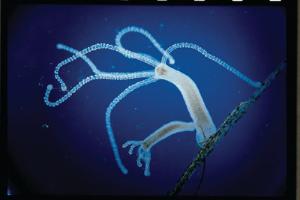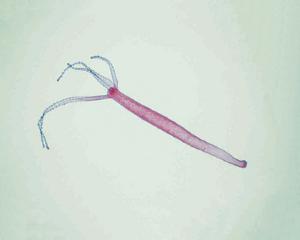How to teach with Hydra: A free guide for working with and caring for your live materials.
Download this care guide for the facts on Hydra reproduction, regeneration, and instructions for their collection, care, and feeding.
Introducing Ward’s How to Teach with Live Materials Series
Curious about teaching with live critters in your classroom, but not sure where to start? Or are you ready to incorporate a new type of specimen in your life science lessons but not sure which one is right for you? We’re here to help with our all-new How to Teach with Live Materials series of free guides. These free downloadable guides are packed with information and expert guidance from our in-house live materials lab technicians and biologists. You’ll get a thorough introduction to the wide world of living specimens and learn how to use them in your classroom to teach hands-on lessons that explore everything from life cycles, animal behavior, comparative anatomy, physiology, bio-chemical processes, disease, health, nutrition, and more!
Read on to learn about teaching with Hydra and discover our other guides in this series at Ward’s World! Check back for more coming soon.
Middle School/High School
How to Teach with Hydra
Hydra belong to the Cnidaria phylum along with sea anemones, corals, and jellyfish. They are a carnivorous species that can be found in healthy freshwater rivers and streams where they attach themselves to plants and rocks.
Naturalist Abraham Trembley's groundbreaking discoveries of the regenerative power of Hydra were first published in 1744. His work has been described as the beginning of developmental biology. Trembley was trying to determine if the green polyp he found was plant or animal in his early work!
Today, researchers experiment with Hydra to investigate many areas like ecology, evolution, regeneration, wound healing, stemness, aging, cancer, and more. At all grade levels, science teachers can develop engaging lessons that introduce beginners to the fascinating world of 'Hydra biology.' Student lessons can range from simple observations to complex investigations that connect Hydra biology to their everyday life. Either way, you’ll generate excitement and curiosity among the “budding” young scientists in your class!
How Hydra regeneration differs from planaria
The ability of some animals to regenerate lost or damaged tissues is impressive. When it comes to regeneration, Hydra and planaria play a masterful “game of clones.” Like planaria, Hydra are one of the few organisms capable of regenerating a complete organism from small tissue fragments or even from dissociated cells.1
The regenerative power of both species depends on reserves of active adult stem cells:2
Pluripotent stem cells (neoblasts) in planaria. Pluripotent cells can give rise to all the cell types that make up the body; embryonic stem cells are considered pluripotent. Pluripotent cells cannot develop into an entire organism on their own.3 A single pluripotent adult stem cell type (“neoblast”) gives rise to the entire range of cell types and organs in the planarian body plan, including a brain, digestive-, excretory-, sensory- and reproductive systems.4
Multipotent interstitial stem cells in Hydra. Multipotent stem cells can self-renew by dividing and developing into multiple specialized cell types present in a specific tissue or organ. Blood cells are an example. Most adult stem cells are multipotent stem cells.5
Research suggests that Hydra are one of the few animals that maintain telomere length and do not go through cellular senescence. Therefore, they are biologically immortal!
Use Hydra in your classroom to help students observe this organism’s remarkable process of regeneration, reproduction, and other biological functions. Download the Working with Hydra guide at the top of this page to help you get started.
For help caring for your live Hydra, check out our Hydra Live Materials Care Guide.
About Ward’s Science Live Materials
Ward’s Science is committed to supplying high-quality specimens that support a wide variety of classroom activities and research. Because we cultivate and care for all of our live materials in our onsite labs, we ensure that your materials are always fresh, healthy, and delivered on time.
Discover our wide selection of live materials for teaching science here.
For more information about how to care for live materials, visit our Live Material Care Guide page; it has instructional and informational literature sheets for the most popular live specimens in our collection. From algae to vertebrates and everything in between, you will find the facts and instructions necessary to properly provide care for your live specimens and enrich your lessons with additional background information.
Our expert biologists and lab technicians are here to help with questions or one-on-one support with your live materials—Email sciencehelp@vwr.com for personalized support, custom orders, and more.
References: 1. NIH - National Center for Biotechnology Information: Cellular and Molecular Mechanisms of Hydra Regeneration 2. Frontiers in Cell and Developmental Biology: Dylan J. Guerin, Cindy X. Kha, and Kelly Ai-Sun Tseng, From Cell Death to Regeneration: Rebuilding After Injury. 3. NY State Stem Cell Science Department of Health, Wadsworth Center 4. Rink JC. Stem cell systems and regeneration in Hydra. Dev Genes Evol. 2013;223(1-2):67-84. doi:10.1007/s00427-012-0426-4 5. Nature Portfolio: Multipotent stem cells.
Recommended products:
[StartProductBlock]

Ward's® Live Brown Hydra (Hydra littoralis)
Watch the feeding reflex in real-time. Observe the reproductive process of budding. Look for similarities and differences between Brown hydra and green Hydra. Vital stained cultures so students can visualize organism structures.
[EndProductBlock]
[StartProductBlock]
Ward's® Live Green Hydra (Chlorohydra viridissima)
Watch the feeding reflex in real-time. Observe the reproductive process of budding. Look for similarities and differences between Brown hydra and green Hydra. Vital stained cultures so students can visualize organism structures. Green hydra are smaller than the strictly carnivorous Brown Hydra.
[EndProductBlock]
[StartProductBlock]

Hydra Slides
Identifying features clearly distinguishable.
[EndProductBlock]
[StartProductBlock]
Eisco® Hydra Model
A three-dimensional dissection shows the Hydra’s mouth coelentron, testis, gland cells, ovum, and ovary.
[EndProductBlock]
